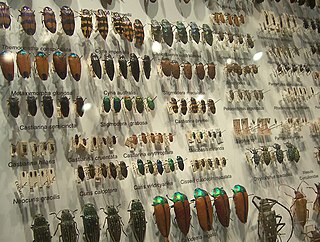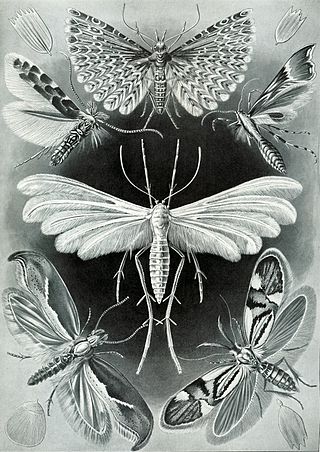
In zoological nomenclature, a type species is the species name with which the name of a genus or subgenus is considered to be permanently taxonomically associated, i.e., the species that contains the biological type specimen(s). A similar concept is used for suprageneric groups and called a type genus.

The Bernice Pauahi Bishop Museum, designated the Hawaiʻi State Museum of Natural and Cultural History, is a museum of history and science in the historic Kalihi district of Honolulu on the Hawaiian island of Oʻahu. Founded in 1889, it is the largest museum in Hawaiʻi and has the world's largest collection of Polynesian cultural artifacts and natural history specimens. Besides the comprehensive exhibits of Hawaiian cultural material, the museum's total holding of natural history specimens exceeds 24 million, of which the entomological collection alone represents more than 13.5 million specimens. The Index Herbariorum code assigned to Herbarium Pacificum of this museum is BISH and this abbreviation is used when citing housed herbarium specimens.

Dru Drury was a British collector of natural history specimens and an entomologist. He had specimens collected from across the world through a network of ship's officers and collectors including Henry Smeathman. His collections were utilized by many entomologists of his time to describe and name new species and is best known for his book Illustrations of natural history which includes the names and descriptions of many insects, published in parts from 1770 to 1782 with copperplate engravings by Moses Harris.

Insect collecting refers to the collection of insects and other arthropods for scientific study or as a hobby. Most insects are small and the majority cannot be identified without the examination of minute morphological characters, so entomologists often make and maintain insect collections. Very large collections are conserved in natural history museums or universities where they are maintained and studied by specialists. Many college courses require students to form small collections. There are also amateur entomologists and collectors who keep collections.

Myxophaga is the second-smallest suborder of the Coleoptera after Archostemata, consisting of roughly 65 species of small to minute beetles in four families. The members of this suborder are aquatic and semiaquatic, and feed on algae.

Francis Walker was an English entomologist. He was born in Southgate, London, on 31 July 1809 and died at Wanstead, England on 5 October 1874. He was one of the most prolific authors in entomology, and stirred controversy during his later life as his publications resulted in a huge number of junior synonyms. However, his assiduous work on the collections of the British Museum had great significance.

Augustus Radcliffe Grote was a British entomologist who described over 1,000 species of butterflies and moths. He is best known for his work on North American Noctuidae. A number of species were named after him, including the moth Horama grotei.
Acanthopteroctetidae is a small family of primitive moths with two described genera, Acanthopteroctetes and Catapterix, and a total of seven described species. They are known as the archaic sun moths.

The Museo Civico di Zoologia is a natural history museum in Rome, central Italy. It is situated next to the Bioparc (Zoo) and can be entered by the Zoo or through the entrance on via Ulisse Aldrovandi. Founded in 1932, it is said to continue the natural history tradition of the Gabinetto di Zoologia dell'Università Pontificia and the collections date from 1792.
Forensic entomology deals with the collection of arthropodic evidence and its application, and through a series of tests and previously set of rules, general admissibility of said evidence is determined. Forensic entomology may come into play in a variety of legal cases, including crime scene investigation, abuse and neglect cases, accidents, insect infestation, and food contamination.

Norman Denbigh Riley CBE was a British entomologist with a special interest in the Lepidoptera and in particular the Lycaenidae. For many years he was keeper of entomology at the British Museum.

George Duryea Hulst was an American clergyman, botanist and entomologist.
In biology, determination is the process of matching a specimen of an organism to a known taxon, for example identifying a plant. The term is also used in cellular biology, where it means the act of the differentiation of stem cells becoming fixed. Various methods are used, for example single or multi-access identification keys.

A zoological specimen is an animal or part of an animal preserved for scientific use. Various uses are: to verify the identity of a (species), to allow study, increase public knowledge of zoology. Zoological specimens are extremely diverse. Examples are bird and mammal study skins, mounted specimens, skeletal material, casts, pinned insects, dried material, animals preserved in liquid preservatives, and microscope slides. Natural history museums are repositories of zoological specimens

The Bohart Museum of Entomology was founded in 1946 on the campus of the University of California, Davis. The museum is currently the seventh largest insect collection in North America with more than seven million specimens of terrestrial and freshwater arthropods. At least 90% of these holdings are insects. The collection is worldwide in scope with the Western Hemisphere, Indonesia, and Australasia particularly well represented.
Józef Razowski is a Polish entomologist and lepidopterist specializing in Tortricidae. He is an honorary member of the Polish Entomological Society and a working member of the Polish Academy of Arts and Sciences (PAU). From 1988 to 1997, Razowski headed the Institute of Systematics and Evolution of Animals.

Annette Frances Braun (1884–1978) was an American entomologist and leading authority on microlepidoptera, a grouping of mostly small and nocturnal moths. Her special interest was leaf miners: moths whose larvae live and feed from within a leaf.
The Walter Reed Biosystematics Unit ("WRBU") is a US Army organization that conducts laboratory and field research on the systematics of medically important arthropods in support of epidemiological investigations and disease prevention and control strategies of importance to the military. Research is carried out worldwide, within geographic or faunistic restrictions of the material available and military requirements. Research efforts focus on the development of accurate and reliable means of identifying vectors of arbopathogens of humans.

The conservation and restoration of insect specimens is the process of caring for and preserving insects as a part of a collection. Conservation concerns begin at collection and continue through preparation, storage, examination, documentation, research and treatment when restoration is needed.
Hiroshi Inoue was a Japanese lepidopterist. He studied a wide range of moths, in particular the families Zygaenidae, Geometridae, and Pyralidae. During his career Inoue authored 1042 taxa.













